My dearest readers,
Prepare yourselves, for I have an intriguing tale to share with you, an astonishing tale of resilience. It all begins in the quiet embrace of the pre-dawn hours of the foothills of the majestic Mount Kenya. As the first rays of the morning sun sneak over the horizon, a golden gradient illuminates the landscape, casting a spell of enchantment upon the rolling hills and valleys. The earth, still with the morning’s dew, glows like scattered fragments of stardust, a testament to the purity of this sacred land.
Once a flourishing paradise now lies a torrid, unforgiving terrain where the blistering sun tormented both man and beast. In these arid lands of Kenya, the scorching rays of the sun beat down relentlessly, and the earth cracked beneath its fiery touch. Amidst this harsh backdrop, dwelled a young girl named Mai. Mai belonged to the Samburu tribe, a people who had long thrived in harmonious coexistence with their environment. Up until now where the same environment threatened their very existence for they faced a crisis that gripped their very lifeline by the neck. The drought had ensnared their lands, withering their livestock and depriving Mai’s aging father, Sakina, of the vital nutrients he needed to combat his cancer.
For Mai, life teetered on a fragile equilibrium. Her father, seemingly embracing the call of death, fought tenaciously to ensure Mai’s well-being, ensuring she received an education while instilling a deep respect for their cultural heritage. Sakina had raised Mai single-handedly, an unprecedented act among the Samburu people, who held the belief that men did not undertake the upbringing of children. However, driven by his enduring love for his first wife, Sakina could not fathom the idea of taking a second spouse following her untimely demise from an mysterious and unidentified ailment.
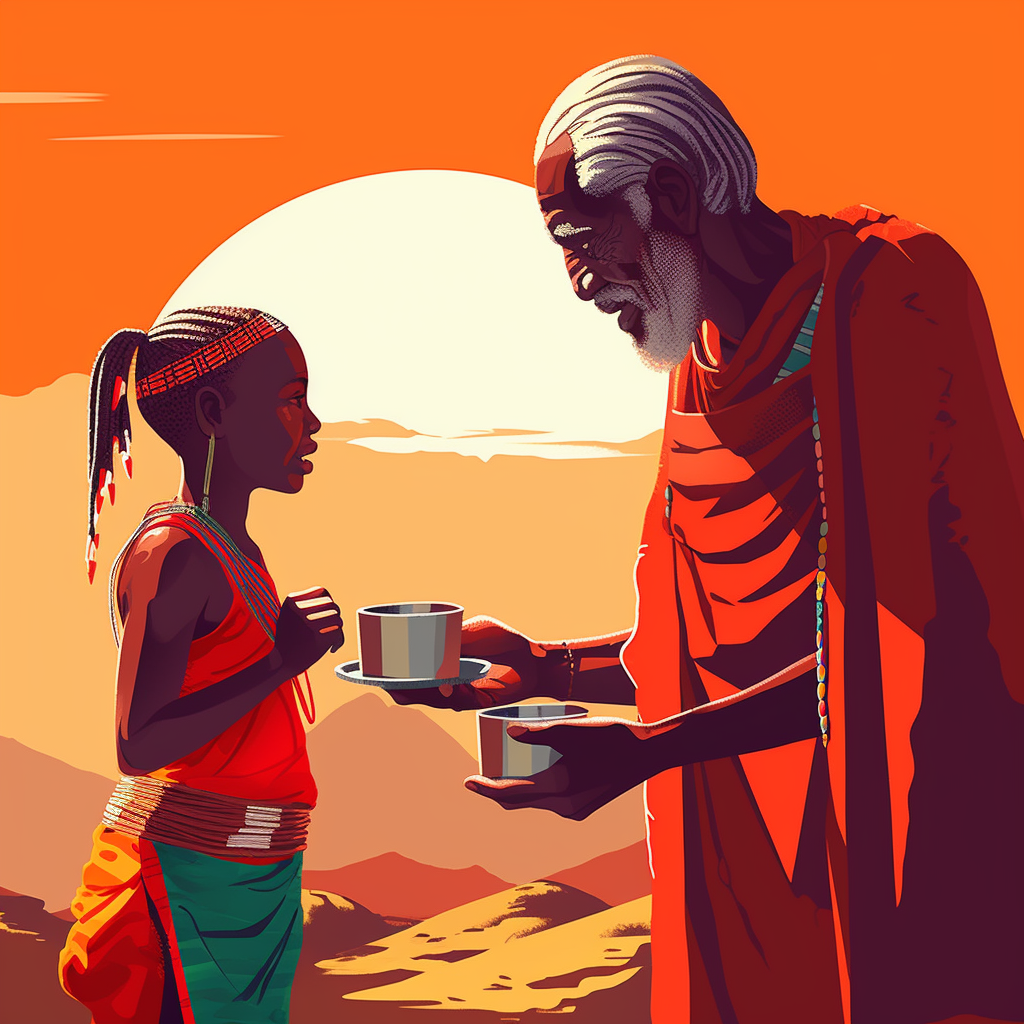
Steven Vala
Every day as the sun rose, so did Mai, her footsteps light yet purposeful as she prepared for another day of life as a young Samburu girl. For her father’s breakfast, she prepared a light assortment of fruits, berries and a glass of slightly mudded water, all that the land can give, hoping they will give him strength to see the rest of the day. Her second duty was gathering water for her household. In the sweltering heat of the scorching sun, she ventured to the water source, the great Ewaso Nyiro River—a place where life and community converge. With a sturdy vessel balanced upon her head, she joined the other women as they traversed the rugged terrain. With every step they took, the Samburu people breathed life into the tales of their ancestors, their traditions echoing through the valleys and canyons. They embodied the spirit of resilience, drawing strength from the land and the creatures that call it home. Together, they collected water from the source, each drop precious and essential, a lifeline that connects them to the very essence of survival.
But something insidious was happening. The water levels in the Ewaso Nyiro were steadily declining with each visit, as if the river itself was gasping for breath, clinging to life. One morning, as Mai embarked on her familiar trek to the river, she felt an eerie sense of foreboding. The parched land before her, cracked and barren, the desolation now broke her heart. Still feeling an eerie sense that something was coming, she arrived at the riverbank, hoping for a glimpse of the familiar shimmering waters. But what she beheld left her breathless with sorrow—the river, once a mighty force of life, had vanished, leaving behind only a dry riverbed, a ghostly reminder of the once-mighty river’s essence.
Tears welled up in Mai’s eyes as she knelt down and pressed her hands onto the cracked earth as if trying to summon the river back to life through sheer force of will. She couldn’t fathom a world without the Ewaso Nyiro, for it had sustained her father, given him relief from cancer and made the bitter herbs bearable; it was also the lifeline for her community for generations, providing water for their crops, their livestock, and their very existence. Oh, what will she do?
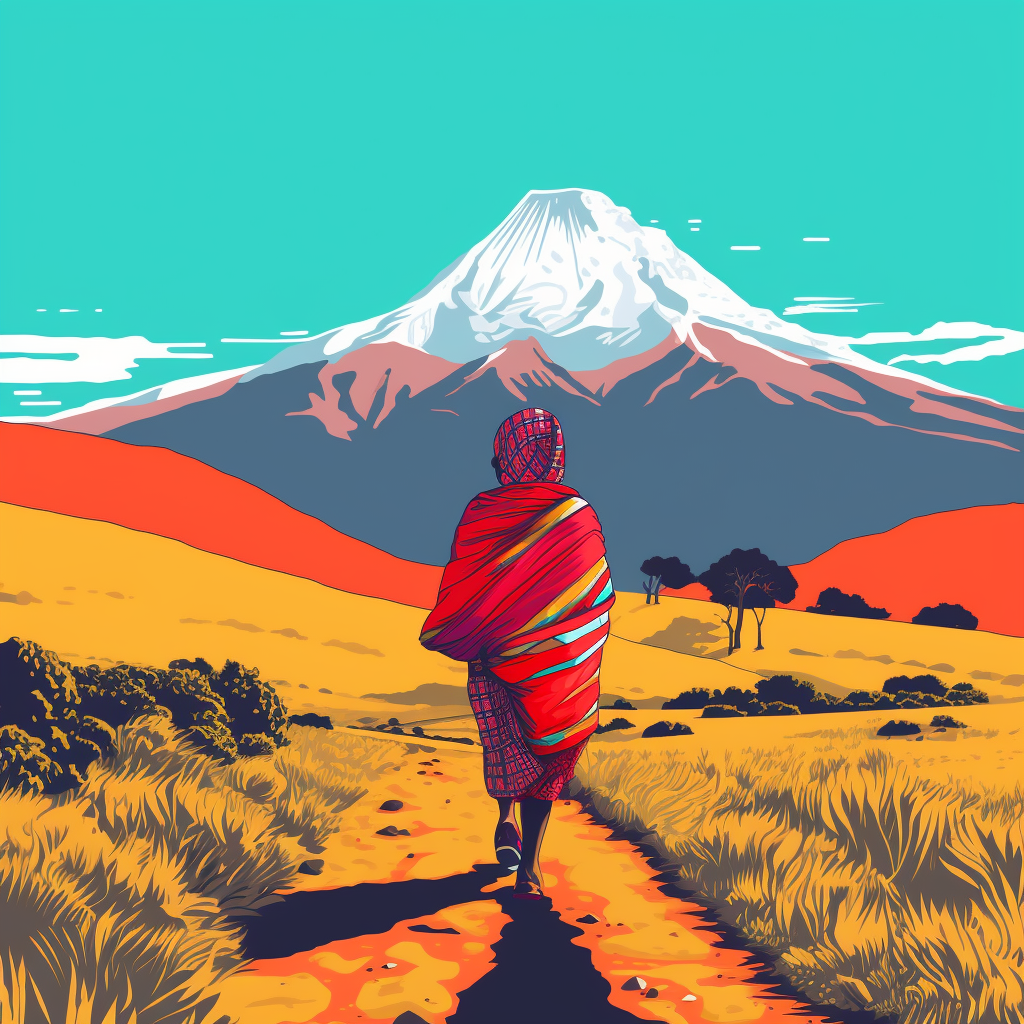
Steven Vala
But her spirit was aflame, aflame with a fire that refused to be extinguished. Filled with a deep sense of purpose, Mai made a vow to find the lost river, restore its voice and bring life back to her people’s lands whilst hopefully adding a few more days for her loving father. Step by step, her journey began. With each step she took, the weight of the burden grew heavier as she bore witness to the myriad of souls ensnared in the web of this water crisis. Fellow beings, their bodies frail and emaciated, their eyes mirrored the desperation etched upon the land.
As she ventured upstream, she began to see green beautiful farms, with water flowing in rows through the land. A whining noise echoed through the air. Curious, she followed the sound. Mai could not believe her eyes, in the heart of the serene river, where its shimmering waters flowed with gentle grace, stood a mechanical contraption that disturbed the tranquility of its existence. Like a monstrous creature of iron and pipes, it reached its mechanical arms deep into the river’s depths, ready to siphon its life force with each sinister pump.
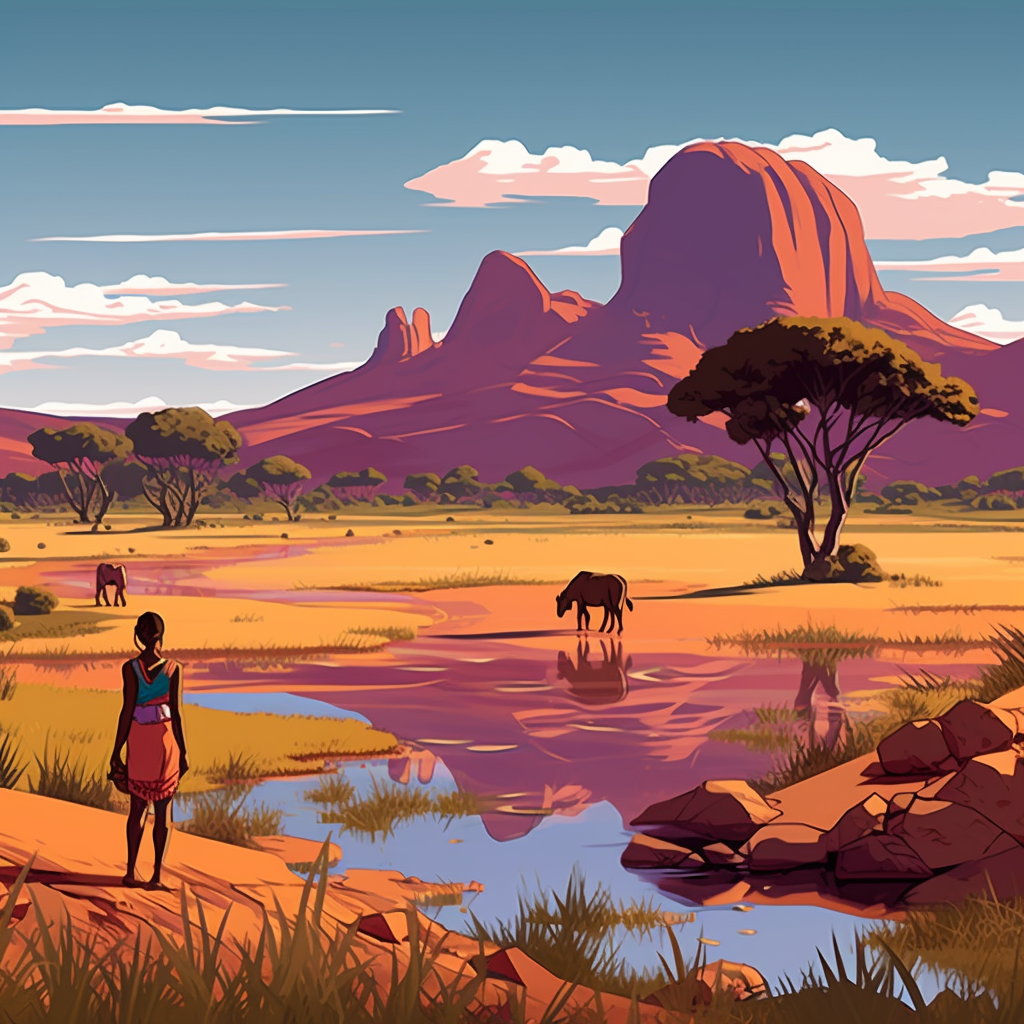
Steven Vala
The river’s water, once clear and pure, now flowed begrudgingly through the veins of the pump. With each pump, its insatiable hunger drew forth the life-giving water that sustains the surrounding land. It is a stolen offering, a precious resource that should be cherished and protected but has fallen victim to the relentless march of human progress. With each pump, the river’s spirit weakened, its lifeblood drained away, leaving it a mere shadow of its former self.
Not too far from the grotesque entity, she witnessed the callous disregard for the river’s purity as pollution tainted its once-pristine waters. Rows upon rows of plastic graced the river, killing wildlife and contaminating the only source of water for Mai and her people. This broke Mai’s heart , for it is the same waters that she prepares her father’s medicine from. A tear run down her cheek. As if that was not enough, on the riverbed itself, she witnessed the relentless logging that tears through its heart. Mai absorbed these painful truths, her spirit intertwined with the river’s sorrow. How could they?
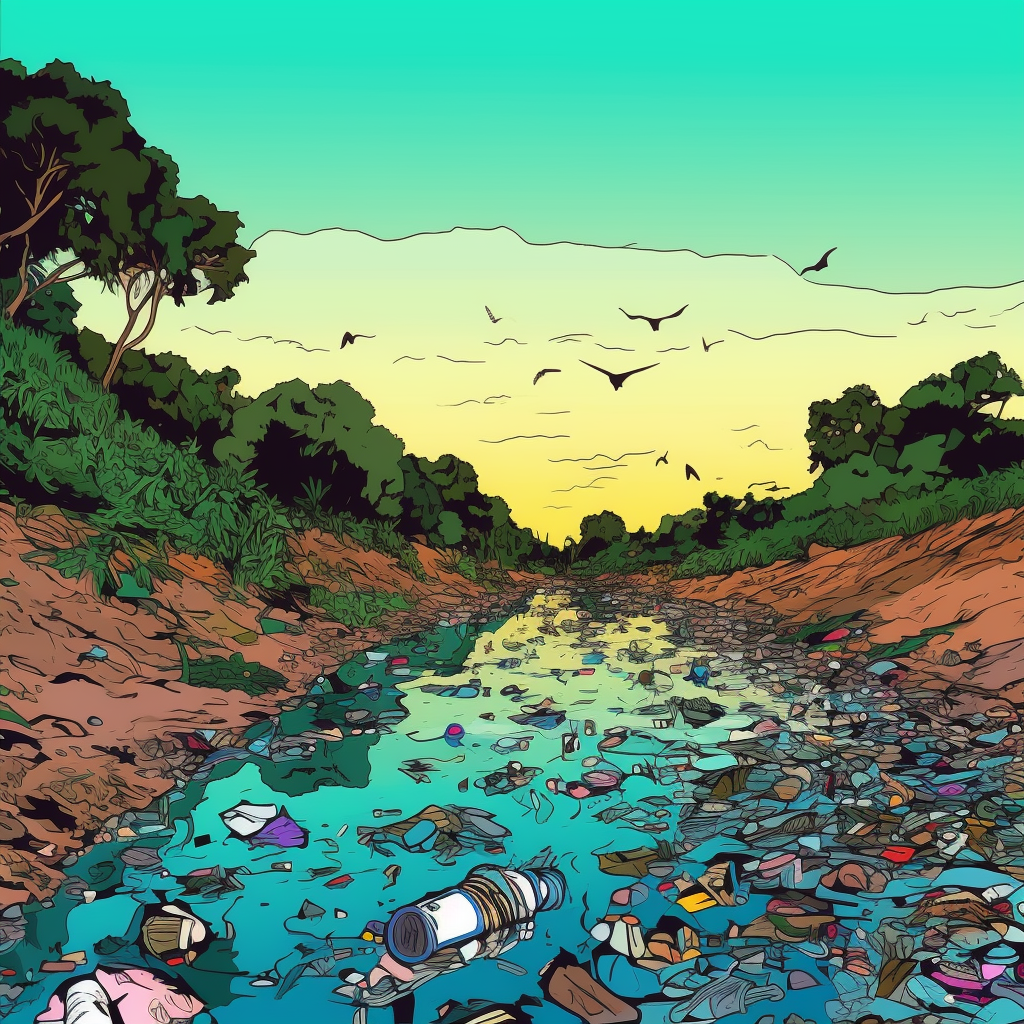
Steven Vala
With determination fueling her steps, Mai pressed onward. Finally, after days of treacherous travel, Mai arrived at Mount Kenya, the sacred source of the Ewaso Nyiro. The mountain, majestic and formidable, stood as a guardian of life, holding within its depths the secrets of the river’s existence. With a mixture of reverence and desperation, Mai began her ascent. The air grew thinner, and her legs ached with fatigue, but her resolve remained unyielding. She climbed until she reached a secluded clearing nestled amidst the mountain’s rugged embrace, where a glistening pool of water awaited her.
Kneeling beside the pool, Mai closed her eyes, reaching out with her senses, hoping to connect with the spirit of the river that resided within the mountain’s heart. With trembling lips and tear-filled eyes, she begged/pleaded with the mountain, pleaded with the very essence of life, to bestow upon them the gift of flowing waters once more. She spoke softly, her voice carrying the weight of generations past and the hopes of generations to come. She spoke of the pain and longing of her people, of the barren lands and the dying wildlife. She implored the mountain to release its life-giving waters once more, to bestow upon them the gift of the river’s presence.
And in that sacred moment, the river spoke. The voice that echoed within Mai’s being was not her own but that of the river itself. The Ewaso Nyiro wept, a mournful elegy for a stolen vitality. It longed for the day when humans will awaken to their interconnectedness with the natural world when they will heed the river’s anguished whispers and stand as guardians rather than plunderers of its life force. Only then will she allow her crystal clear waters to cascade upon our faces.
Equipped with this newfound knowledge, Mai descended from the mountain, her spirit aflame with purpose. She knew that the journey to restore the river’s voice was not hers alone; it was a mission that required the collective effort of her community.
Mai returned to her village, her heart ablaze with a fervor she couldn’t contain. She gathered her playmates, their young eyes shining with innocence and curiosity. She shared her story, weaving a tapestry of hope and responsibility, teaching them the importance of water conservation, and urging them to be the catalysts of change.
The children listened with complete attention, their hearts stirred by Mai’s words. And just like the telephone game, her playmates told the other children in the village, who told their mothers, who told their husbands, who told the great council of elders of the story of Mai and the message of the Ewaso Nyiro. A ripple turns into a tidal wave.
And so, Mai’s campaign began. One by one, parents were encouraged by the passionate voices of their children. They rose urgently, demanding policies that would protect the river, ensuring its sustainable use for future generations. Their united plea reached the national government, piercing through the layers of bureaucracy and indifference.
Moved by the unwavering determination of the people, the government implemented water-saving policies, heralding a new era of awareness and collective responsibility. The wheels of change were set in motion as communities across the nation rose to the challenge, working tirelessly to conserve what little remained of their beloved Ewaso Nyiro River.
County governments repaired leaking water pipes and revitalised aging water infrastructure, ensuring that every precious drop was used wisely. The communities surrounding the river took the initiative and organized cleanup efforts to restore the river’s purity, removing the scars of neglect and pollution.
And then, one day, as the people laboured together and created a symphony of hope, the river heard their call. It witnessed the transformation unfolding around its banks, the unity and determination that had sparked a revolution of consciousness.
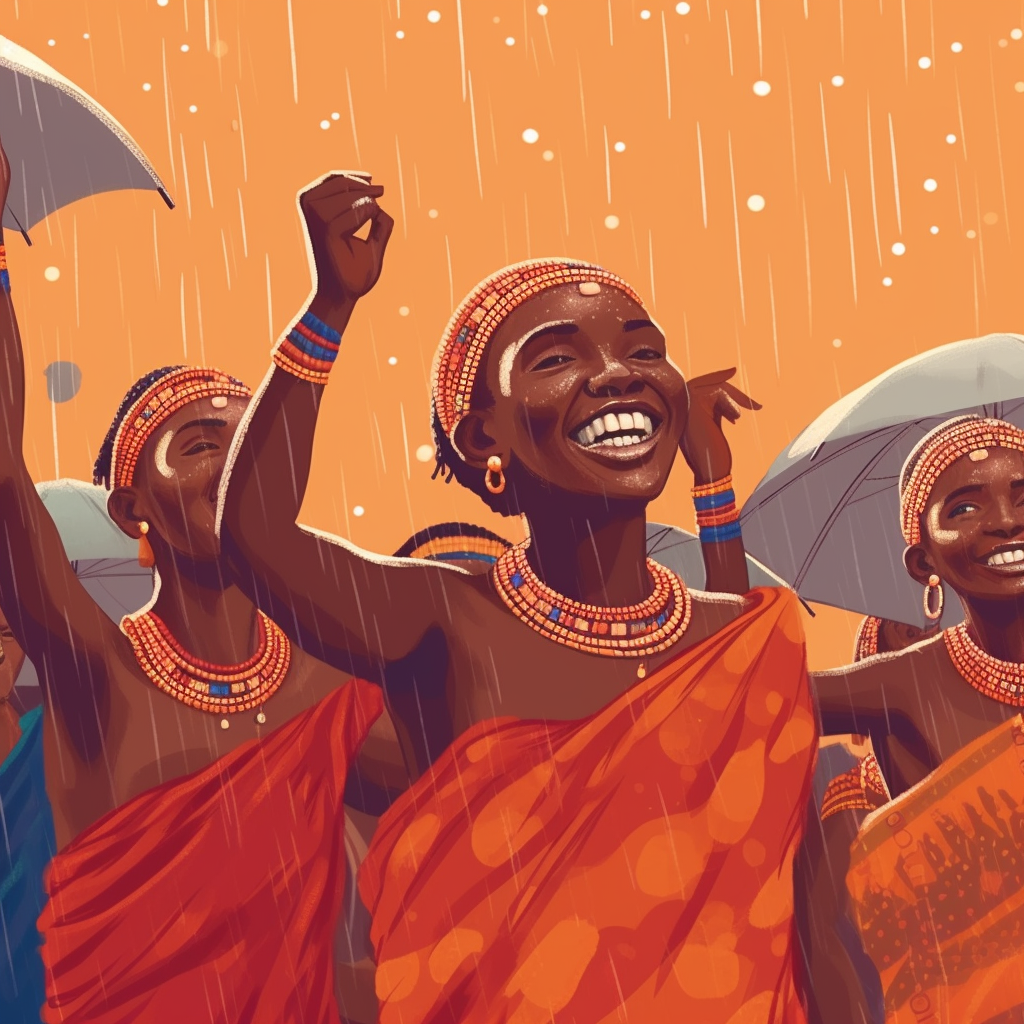
Steven Vala
And so, in a display of joyous celebration, the heavens opened. The raindrops, like tiny messengers from the divine, whispered tales of resilience and hope. Each drop told a story of endurance, of a land and its inhabitants weathering the storm and emerging stronger on the other side.
It is a testament to the indomitable spirit of Mai and her people, who, through their unwavering determination, brought life back to the river and found their own voices in the process. Sakina, in the midst of the celebrations, called for Mai. He looked at her with the widest smile she had ever seen and said: “My daughter, you’ve soothed my heart. You are the source of my pride.” And for the first time in her life, he hugged her.
And to this day, they say that if you listen carefully, standing by the banks of the Ewaso Nyiro, you can hear the her voice singing a song of gratitude and renewal sung in the gentlest of trickles.
Your budding storyteller,
Idah Murithi